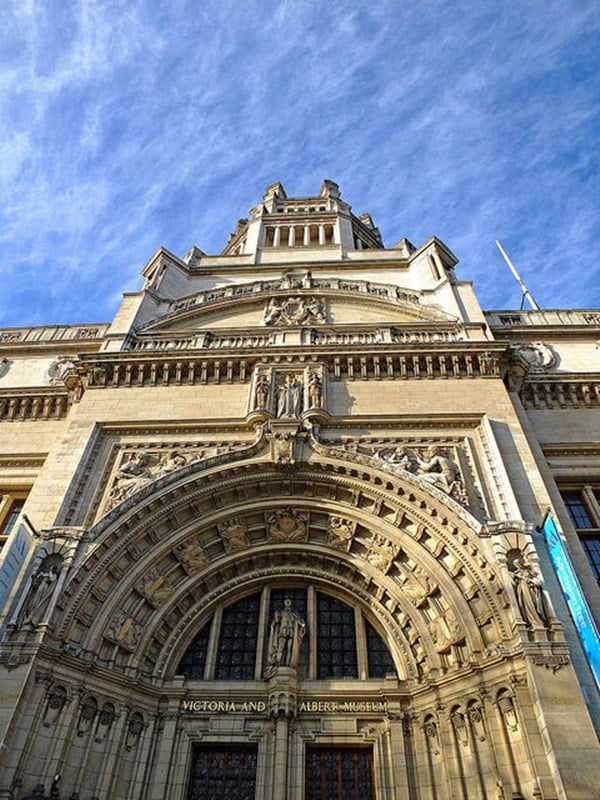
The Victoria & Albert Museum could be among the UK institutions hardest hit by the new copyright regulations.
Photo: Steven Feather via Flickr
Have you been following the increasingly alarming changes to copyright provisions?
Europe seems to be leading the way, though backwards, in what amounts to an attack on the viability of museums, publishers and art-related businesses to work with artists and estates on reproduction rights. It also threatens artists, too, criminalizing appropriation when it is considered a copyright violation.
Art museums and publishers are currently trying to work out how to respond to the new British copyright law, which goes into effect in 2020 and effectively makes it more expensive to reproduce images in publications and on goods offered in museum shops.
But what’s got everyone really worried is that the new regulation makes copyright breach in Britain a criminal, rather than a civil, offense. That is not just out of proportion but totally and utterly insane.
Are we now going to start sending art publishers, authors, artists and museum curators to jail?
Even those that want to comply with the law say they may not have the funds to do so and argue that the provisions are unreasonable given the economics of the businesses they are involved in. One museum official in Britain says it could cost over $1.3 million a year to comply with the new regulation. Meanwhile a publisher says of the art book publishing business that “a title priced at under £10 [$15] with 200 images incurs extra licensing fees of £72 [$108] per image, leading to extra costs of £14,400 [$21,500] and probable abandonment of publication.”
The changes are outlined in a report from the British Intellectual Property Office with the sleep-inducing title “Transitioning provisions for the repeal of Section 52 of the Copyright, Designs, and Patents Act 1988” and subtitled “Government response to the consultation and announcement of transitional provisions.”
The changes stem from the repeal of Section 52, which restricts design rights on mass-produced items to 25 years after manufacture. According to a report in the Antiques Trade Gazette, “this allows designers to exploit their ideas commercially while protecting the consumer by limiting the monopoly to a quarter of a century, after which time competing products became legal.” (See UK Museums Display Empty Vitrines to Protest Against Copyright Laws and 91 Million Orphaned Artworks Are Now Free to the Public).
However, European harmonization rules and a court case in Italy convinced the British government that the change was in order.
The changes are retroactive, meaning that in some cases where image rights have expired they will be revived. That means museums will have to check every image in every book they sell in their stores, as well as images on promotional items like mugs and cards. (See British Museums Warned About Selling Off Works and Does Britain Need A New Tate Modern?)
If rights have been revived, the museums will then need to apply for additional licensing and thus face higher costs. Failure to do so will constitute a breach of rights and be considered a criminal offense. That’s unreasonable and impractical, they say, something courts and governments don’t seem to have considered.
Among British institutions that will likely be hardest hit are the Victoria & Albert Museum, as well as the Design Museum, which ironically pushed for the law change as it brings new rights to designers. That seems to have backfired.
The new law doesn’t just affect museums and publishers, but also artists and designers. What happens, for instance, when an artist or designer borrows work or ideas from another artist or designer to make a new work, a longstanding tradition in creative industries? (It is hard to imagine the Rolling Stones without the influence of James Brown or Jeff Koons without Andy Warhol). If found guilty of violating copyright, these artists have committed a criminal offense!
Do we really want to start putting artists and designers in jail or cluttering up courts with vexatious criminal copyright actions?
Gazette editor Ivan Macquisten is worried about this very question: “at first glance, the repeal of section 52 seems a boon for designers . . . However, as always the devil is in the details and some of the leading intellectual property specialists in the country have argued that it will have a chilling effect on new design, because young designers must ensure that they do not fall foul of the law when inspired by earlier designers.”
For more on copyright law, see French Court Copyright Law Ruling Threatens Art Market Price Transparency.